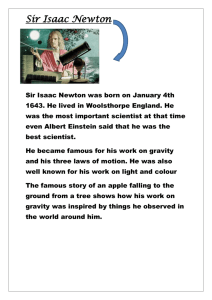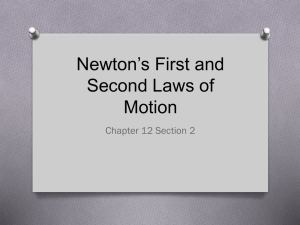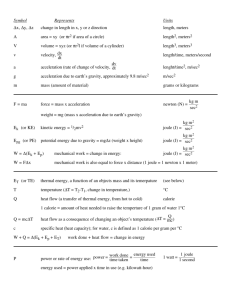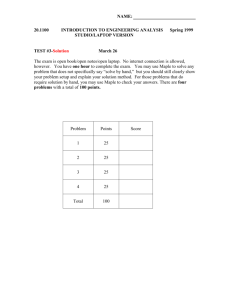RSLG Review Guide
advertisement
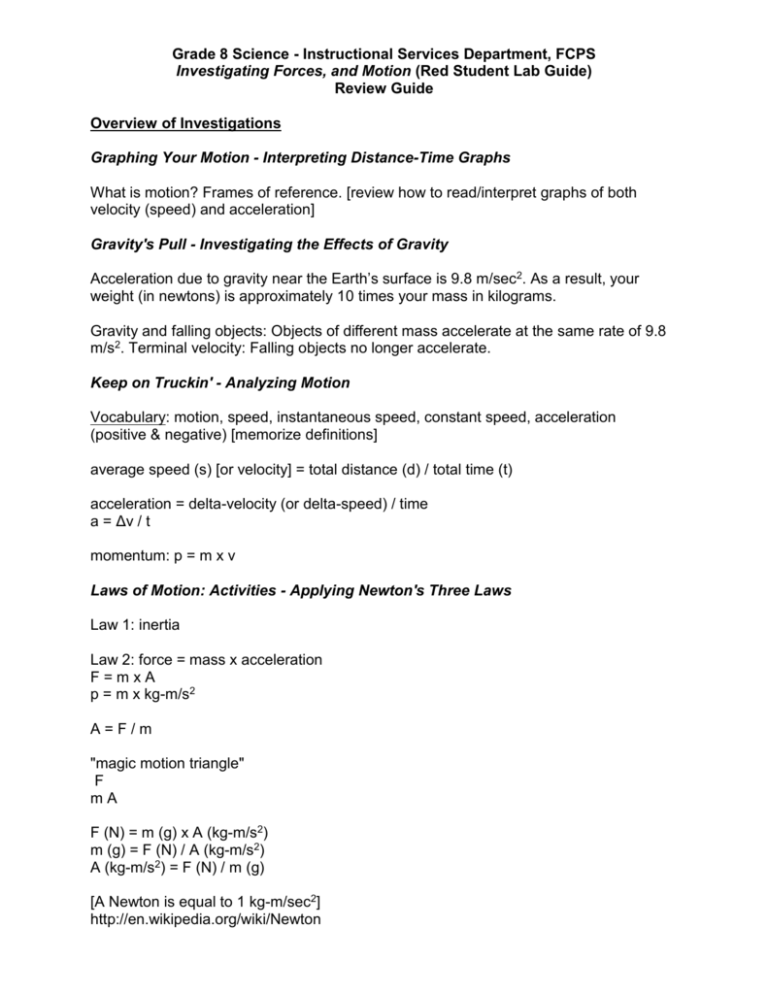
Grade 8 Science - Instructional Services Department, FCPS Investigating Forces, and Motion (Red Student Lab Guide) Review Guide Overview of Investigations Graphing Your Motion - Interpreting Distance-Time Graphs What is motion? Frames of reference. [review how to read/interpret graphs of both velocity (speed) and acceleration] Gravity's Pull - Investigating the Effects of Gravity Acceleration due to gravity near the Earth’s surface is 9.8 m/sec2. As a result, your weight (in newtons) is approximately 10 times your mass in kilograms. Gravity and falling objects: Objects of different mass accelerate at the same rate of 9.8 m/s2. Terminal velocity: Falling objects no longer accelerate. Keep on Truckin' - Analyzing Motion Vocabulary: motion, speed, instantaneous speed, constant speed, acceleration (positive & negative) [memorize definitions] average speed (s) [or velocity] = total distance (d) / total time (t) acceleration = delta-velocity (or delta-speed) / time a = Δv / t momentum: p = m x v Laws of Motion: Activities - Applying Newton's Three Laws Law 1: inertia Law 2: force = mass x acceleration F=mxA p = m x kg-m/s2 A=F/m "magic motion triangle" F mA F (N) = m (g) x A (kg-m/s2) m (g) = F (N) / A (kg-m/s2) A (kg-m/s2) = F (N) / m (g) [A Newton is equal to 1 kg-m/sec2] http://en.wikipedia.org/wiki/Newton "In physics, a derived SI unit, the newton (symbol: N) is the unit of force, named after Sir Isaac Newton in recognition of his work on classical mechanics. It was adopted by the General Conference on Weights and Measures (CGPM) in 1960. It is defined as the amount of force required to accelerate a one-kilogram mass at a rate of one meter per second per second. Its dimensions in SI base units are m x kg/s2. It is also the unit of weight, as weight is the force acting between two objects due to gravity. A mass of one kilogram near the Earth's surface has a weight of approximately 9.81 newtons, although this figure varies by a few tenths of one per cent over the Earth's surface. Conversely, an object with a mass of 102 grams weighs roughly one newton [1,000 g/9.81 N = 101.94]. Rather fittingly, given the story about Newton's discovery of gravity, this is about the mass of a small apple." (or ~7 fig newtons!) Law 3: action-reaction The Force of Friction - Designing Your Own Experiment Friction is a force that resists motion between two surfaces that are in contact. Work Made Easy - Using Simple Machines Vocabulary: simple machine, work, mechanical advantage, efficiency [memorize definitions] Simple machine: A device that does work with only one movement. A machine makes it easier to do work. Part 1: Time to Work Work: When a force moves an object through a distance (in the same direction as the force). Work, like energy, is measured in Joules (J); one Newton-meter equals one Joule. W (N-m) = F (N) x d (m) If you lift a 500 g mass (a.k.a., the resistance) to a height of 20 cm, then you do 1 Joule of work: W (N-m) = 5 N x .2 m W = 1 N-m or 1 Joule A Newton is the force required to accelerate 1 kg (of mass) 1 m/sec2. [1 meter per sec per sec.] This can be expressed mathematically: 1 N = 1 kg x m/sec2 How many [Fig] Newtons is a Newton? W = F x d; F = m x a; F = .5 kg x 9.8 m/s2; F = 4.9 kg-m/s2 or 4.9 N Part 2: What Difference Does a Machine Make? - effort force: the force applied to a machine (Fe) - effort distance: the distance the effort force moves using the machine (de) - resistance force (Fr): The force applied by a machine to overcome the resistance; this is the same as the force which would have to be applied without the machine. - resistance distance (dr) is the distance the resistance moves; it is the same distance the resistance would move without the machine. - mechanical advantage (MA): the advantage of using a machine; it tells the number of times the machine multiplies the force. MA = Fr / Fe - efficiency = W o/Wi x 100 work output versus work input "magic work triangle" W Fd W (N-m) = F (N) x d (m) F (N) = W (N-m) / d (m) d (m) = W (N-m) / F (N) Power to Do Work - Calculating Power Power: The rate at which work is done, calculated by dividing the amount of work done by the time it takes to do the work. The unit of power is the watt (W). One watt is equal to one Joule of work done in one second. Work (J) = Force (N) x distance (m) Power (W) = work (J) / time (sec)
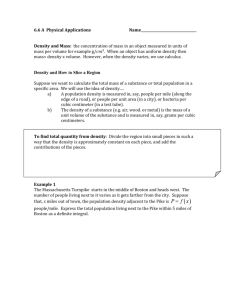

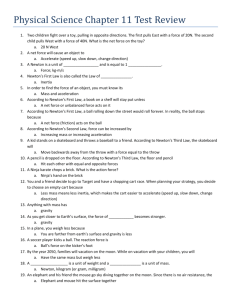
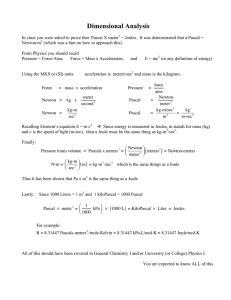

![How Many [Fig] Newtons in a newton](http://s3.studylib.net/store/data/005888918_1-80c84ce9709034996829e4f63643b1e0-300x300.png)
